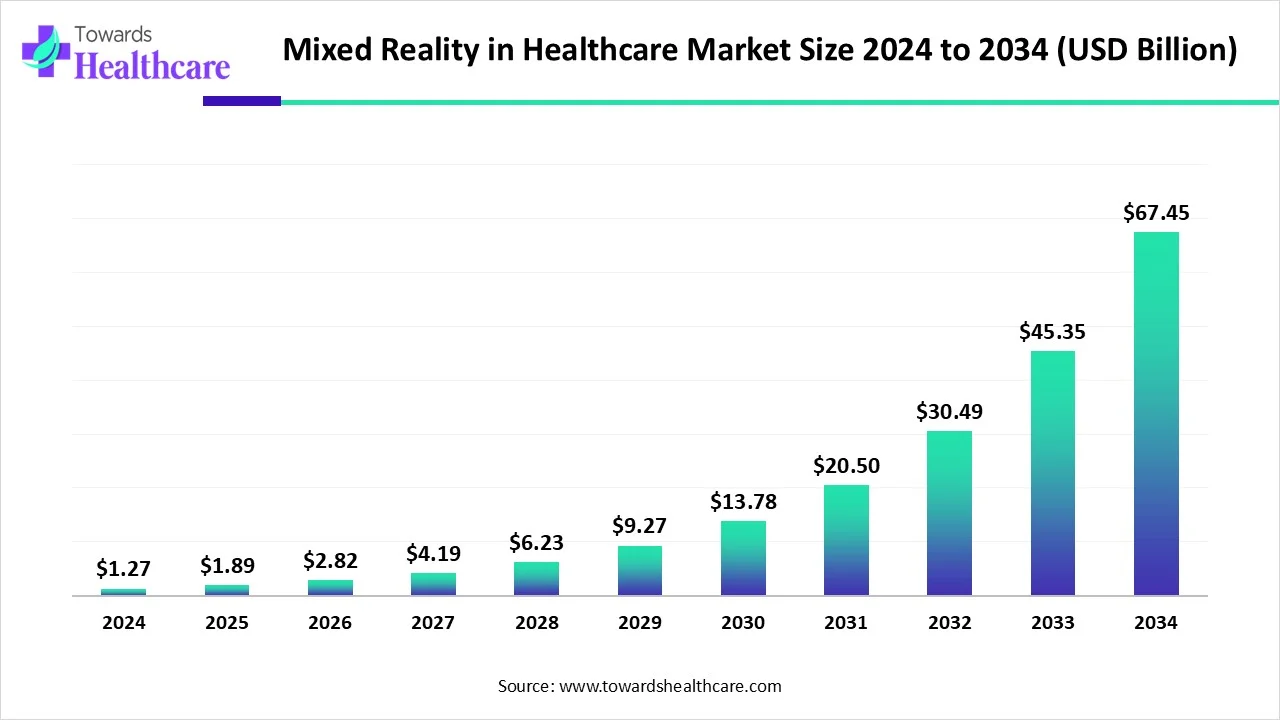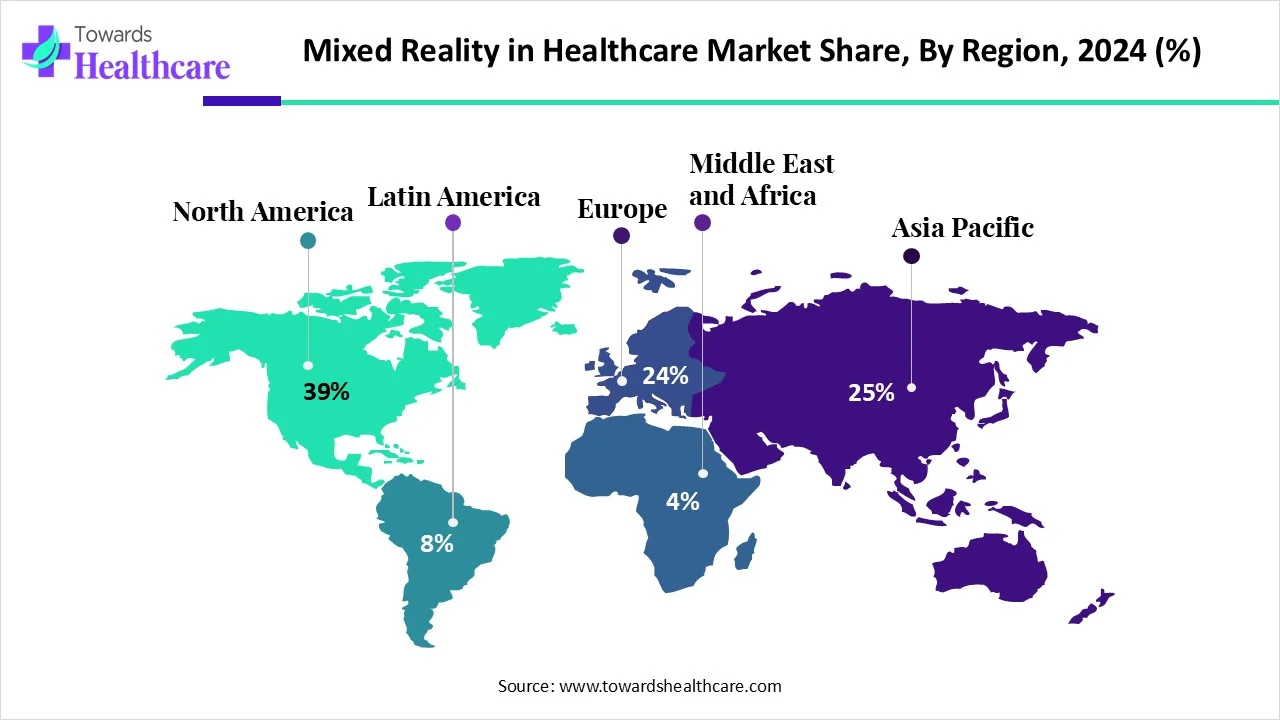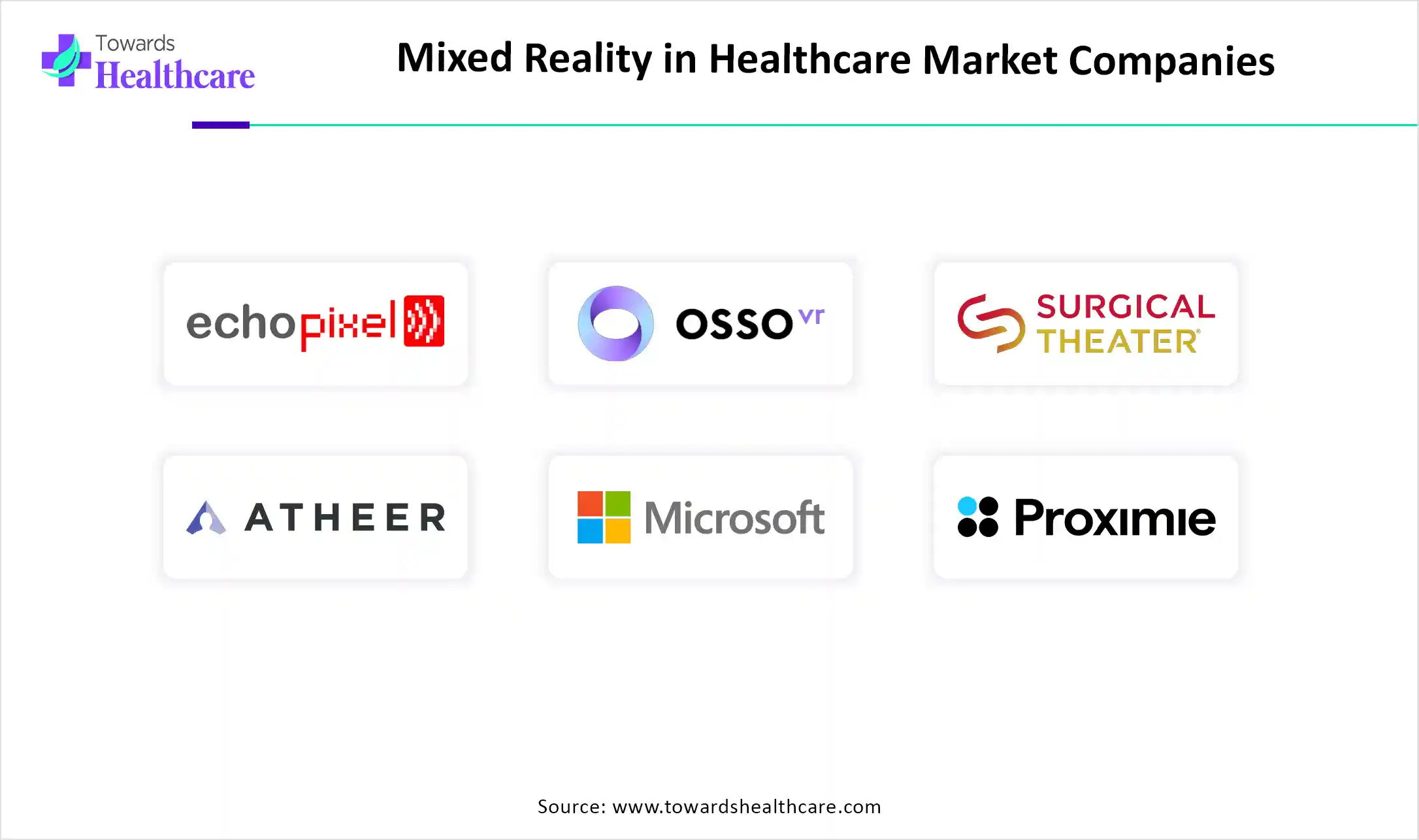December 2025

The global mixed reality in healthcare market size is calculated at USD 1.27 billion in 2024, grow to USD 1.89 billion in 2025, and is projected to reach around USD 67.45 billion by 2034. The market is expanding at a CAGR of 48.74% between 2025 and 2034.
The mixed reality in healthcare market is expanding rapidly due to its ability to enhance surgical precision, improve medical training, and support patient education through immersive, real-time experiences. MR allows healthcare professionals to visualize organs, tissue, and procedures in 3D, leading to better outcomes and reduced error. Its increasing adoption in remote consultation, simulation-based learning, and preoperative planning, along with rising investment in digital health technologies, is significantly driving market growth across various medical specialties.

| Metric | Details |
| Market Size in 2025 | USD 1.89 Billion |
| Projected Market Size in 2034 | USD 67.45 Billion |
| CAGR (2025 - 2034) | 48.74% |
| Leading Region | North America share by 39% |
| Market Segmentation | By Component, By Application, By End-use, By Regions |
| Top Key Players | EchoPixel, Osso VR, Inc, Surgical Theater, Inc., Atheer, Inc, Microsoft, SAMSUNG, HTC Corporation, Proximie, Magic Leap, Inc., Koninklijke Philips N.V. |
Mixed reality in healthcare refers to the use of advanced technology that blends the physical and digital worlds to enhance medical and surgical planning and patient care through interactive immersive experiences. The market is rapidly evolving as hospitals and medical institutions adopt immersive technologies for better patient care and clinical outcomes. MR is being widely used in surgical planning, medical training, and patient education by combining real-world and digital elements. This shift is enhancing precision, reducing errors, and improving learning experiences for healthcare professionals. Increased focus on innovation and digital transformation in healthcare is further fueling the adoption of the market.
For Instance,
AI is significantly enhancing mixed reality (MR) in healthcare by enabling more precise data analysis, real-time decision-making, and personalized patient care. When integrated with MR, AI can help create dynamic, responsive training simulations and improve surgical planning by analyzing complex medical data and projecting accurate 3D visuals. This combination also supports remote diagnostics and patient monitoring. As a result, AI-powered MR solutions are driving innovation, improving clinical outcomes, and expanding adoption across various medical fields.
The Growing Demand for Advanced Medical Training
The rising need for advanced medical training is boosting the use of mixed reality in healthcare, as it allows learners to experience clinical scenarios without risking patient safety. It helps in developing critical thinking, decision-making, and technical skills by replicating real-life situations. Mixed reality also bridges the gap between theory and practice, especially in surgical training and emergency response, making education more engaging, effective, and accessible across diverse healthcare institutions.
For Instance,
High Cost of Technology Implementation
The high cost of technology implementation is a major restraint in the mixed healthcare market because it involves expensive hardware like headsets, specialized software, and system integration. Many healthcare facilities, especially in low- and middle-income regions, struggle to allocate budgets for such advanced tools. Additionally, ongoing maintenance, training costs, and infrastructure upgrades increase the financial burden, making it difficult for widespread adoption despite the technology’s potential benefits in medical training and patient care.
Integration of Artificial Intelligence with Mixed Reality Systems
Combining artificial intelligence with mixed reality opens new possibilities in healthcare by creating smarter, adaptive systems. AI can analyze user performance in real time, guide medical procedures with precision, and customize training based on individual learning needs. This integration also enhances patient simulations, supports quicker decision-making, and improves overall treatment accuracy. As both technologies advance, their combined diagnostics and patient interaction offer a more efficient and immersive medical experience.
For Instance,
The software segment leads the market as it serves as the backbone for creating interactive, responsive, and realistic virtual environments. It enables seamless integration with existing healthcare systems and supports functions like 3D modeling, real-time feedback, and AI-driven diagnostics. With the growing demand for tailored training modules and enhanced clinical workflow, software solutions are being widely adopted, offering greater versatility and innovation compared to hardware, which contributes to their market growth.
The content and application segment is projected to grow at the fastest rate in the mixed reality healthcare market due to the increasing focus on creating realistic medical scenarios for training and therapy. The rising need for condition-specific applications, such as virtual surgeries and patient rehabilitation, is driving innovation in this space. Additionally, advancements in software development and rising investment in healthcare education technologies are making content-rich, interactive applications more accessible and effective for both professionals and patients.
In 2024, the patient care management segment led the mixed reality healthcare market due to its ability to enhance patient engagement, improve recovery outcomes, and support personalized treatment plans. Mixed reality technologies allowed healthcare providers to visually explain conditions and procedures, making patients more involved in their care. It also supported remote monitoring and guided therapies, reducing hospital visits while maintaining care quality.
The surgery and surgery simulation segment is projected to grow at the fastest pace due to the increasing demand for advanced tools that enhance surgical planning and training. Mixed reality offers life-like, interactive environments where surgeons can practice complex procedures without real-life risks. It also supports intraoperative guidance, helping improve accuracy and reduce complications. The rise in minimally invasive surgeries and focus on improving surgical outcomes are further fueling the adoption of MRI in this application area.
For Instance,
The hospitals segment held the largest share of the market due to their widespread use of immersive technologies to enhance clinical workflows and patient interaction. With growing pressure to improve healthcare quality and reduce errors, hospitals are turning to MR for accurate diagnostics, surgical preparation, and medical training. Their ability to invest in innovative tools and integrate them into routine care gives hospitals a clear advantage over smaller facilities, driving market expansion.
The surgical centers and medical institutes segment is expected to see the fastest growth in mixed reality adoption due to their emphasis on advanced training methods and precision-driven procedures. These institutions are actively incorporating MR to enhance surgical education, improve skill development, and support innovative research, with a growing need for realistic simulation environments and increasing collaboration with tech developers. They are well-positioned to adopt MR solutions, driving faster market expansion.
For Instance,

North America led the market share by 39% in 2024.due to its strong presence of key technology players, early adoption of advanced healthcare solutions, and well-established medical infrastructure. The region benefits from significant investments in digital innovation, high awareness among healthcare professionals, and supportive regulatory frameworks. Additionally, the growing use of MR in surgical training, diagnostics, and patient care, along with collaboration between tech firms and medical institutions, contributed to its dominant market position.
For Instance,
The U.S. market is expanding rapidly, driven by a combination of strong technological innovation, high healthcare investment, and robust infrastructure. Healthcare providers are increasingly integrating MR in areas like surgical planning, diagnostics, and remote collaboration. Substantial private and public funding supports the development and deployment of MR solutions. Additionally, the presence of leading MR developers and growing pilot programs across academic medical centers and hospitals is fueling implementation and adoption across the country.
For Instance,
Canada’s market is growing due to its focus on modernizing medical education and improving surgical outcomes through advanced technology. Increasing partnerships between healthcare providers and tech innovators are driving the development of MR-based training and treatment tools. Additionally, strong support for healthcare digitization, rising demand for minimally invasive procedures, and the push for more interactive patient care solutions are contributing to the market’s steady expansion across the country.
Asia-Pacific’s market is set to expand at the fastest rate due to the region’s push toward modernizing healthcare delivery and education. With a rising focus on improving clinical outcomes and addressing skill gaps, medical institutions are embracing MR for immersive training and surgical planning. Strong economic growth, increasing tech-savvy populations, and expanding collaborations between global MR providers and local healthcare systems are further propelling adoption across countries like India, China, and Southeast Asia.
China’s market is expanding due to rapid digital transformation in its medical sector, strong government support for smart healthcare initiatives, and rising investment in advanced technologies. Hospitals and universities are increasingly using MR for surgical training, diagnosis, and patient engagement. Additionally, collaborations between tech giants and healthcare providers, along with a large population demanding better medical services, are driving the adoption of MR solutions across the country.
India’s market is expanding rapidly due to significant investments in digital health and strong public-private partnerships. Hospitals and academic institutions are deploying MR for surgical planning, education, and remote patient consultations. Government support for smart healthcare and the launch of XR-based ecosystems, like those at Amrita Hospital and AIIMS, are fueling innovation. Rising demand for accessible, precision-oriented medical services among India’s growing population also underpins market growth.
Europe is advancing the market through major initiatives and collaborations. For instance, the EU-funded H2020 MED1stMR project is using MR to train over 200 emergency responders across countries like Germany, Austria, and Belgium. Hospitals such as Charité Universitätsmedizin Berlin and institutions like KU Leuven are actively integrating MR into medical education and simulations. Supportive funding, strong digital infrastructure, and partnerships with tech firms are collectively driving the region’s rapid adoption of MR in healthcare.
The UK’s market is expanding thanks to strong investment in digital innovation and collaboration between the NHS and tech startups. Initiatives like XR Health UK are developing full treatment suites, while Health Education England granted £1 million for MR surgical training tools. Major hospitals and universities are piloting MR in surgery and rehabilitation, highlighting clinical benefits and encouraging broader adoption across the healthcare system.
For Instance,
Germany's market is advancing due to its emphasis on high-precision medical care and education. Institutions are increasingly adopting MR tools to enhance medical simulations and improve preoperative planning. The presence of established medical device manufacturers and research institutions fosters rapid innovation. Additionally, growing interest in personalized and minimally invasive treatments is pushing healthcare providers to adopt MR technologies to deliver more accurate and patient-specific care solutions across the country.

The FDA launched the “Home as a Health Care Hub” initiative to enhance health equity using AR/VR to turn homes into healthcare spaces. In partnership with a health-focused architecture firm and with input from patients, providers, and industry experts, the FDA aims to design an immersive home care model. Dr. Jeff Shuren and Dr. Michelle Tarver stated that the AR/VR-enabled prototype is expected to be completed later this year. (Source - Mobile Health News)
By Component
By Application
By End-use
By Region
December 2025
December 2025
December 2025
December 2025